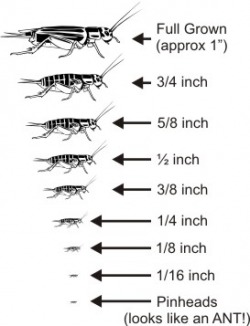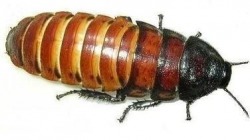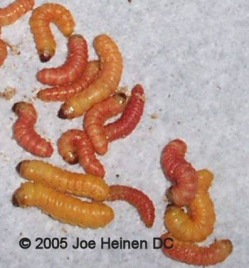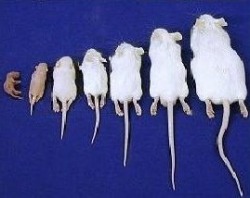PLEASE NOTE
The information on the BambooZoo site is as much as 10 years old and in the hobby much has been learned. I believe in the merit of keeping the site open and available.
These beings are as complicated as we are and deserve more than a basic 5 paragraph care sheet to maintain their health and well being. Please use BambooZoo as a beginning of your research.
Life has changed for us and my time and effort is being used to Change the World.
COMPLETE GUIDE TO FEEDERS
this page has been divided and upgraded
please follow this link.
THE FEEDERS
THE FOLLOWING NUTRITION STATS ARE MEANT AS A GENERAL GUIDE. WHILE SOME SOURCES VERIFY SIMILAR NUMBERS, OTHERS I MAY HAVE FOUND AT ONLY ONE SOURCE.
At the bottom of the page you will find the links to any resources I have used and or found. Some are technical papers that will provide a further understanding of the methods used and MANY more details on vitamins, diets, etc.
****Please note that on many I have posted a/more links to care and feeder sheets.
I would prefer to have a developed page in house. If you have written a web, blog, post that is detailed and with photos please contact me. As with all guest pages a link of your preference will be placed at the top of the page. [email protected]
****PLEASE NOTE
Differing styles of reporting information:
The first style:
Statistics are taken from what is called dry matter, meaning that prior to testing the insect has been freeze dried in a vaccuum oven. The moisture removed during process. You will find many of the following listings have been taken from this type of chart.
C.P. Crude Protein
C.F. Crude Fat
Ash Ash is the total of all minerals
G.E. Gross Energy Kcal also = gross energy
C.A. Calcium
N/A Not analyzed
A second way of providing stats have been done like this:
Moisture % 62.3
Fat % 5.25
Ca:P Ratio % 1.7
Protein % 41.0
Ca:P% = calcium to phosphorous ratio.
A 3rd way of providing stats is done by a gram basis:
The use of this style means that the stats relate to human consumption.
Protein (g) 13.4
Fat (g) 1.4
Carbohydrate 2.9
Calcium (mg) 22.6
Iron (mg) 6.0
calcium is expressed in one more way:
as a CPPM value
ppm are simply part per million as percent (%) are just part per hundred.
So, 1% = 10000ppm. (whispering thanks Cerberus)
For each insect a care and breeding link will be placed in with the specific insect / rodent. Barring the availability of care sheets I will try to pass you forward to as much information as possible.
Differing styles of reporting information:
The first style:
Statistics are taken from what is called dry matter, meaning that prior to testing the insect has been freeze dried in a vaccuum oven. The moisture removed during process. You will find many of the following listings have been taken from this type of chart.
C.P. Crude Protein
C.F. Crude Fat
Ash Ash is the total of all minerals
G.E. Gross Energy Kcal also = gross energy
C.A. Calcium
N/A Not analyzed
A second way of providing stats have been done like this:
Moisture % 62.3
Fat % 5.25
Ca:P Ratio % 1.7
Protein % 41.0
Ca:P% = calcium to phosphorous ratio.
A 3rd way of providing stats is done by a gram basis:
The use of this style means that the stats relate to human consumption.
Protein (g) 13.4
Fat (g) 1.4
Carbohydrate 2.9
Calcium (mg) 22.6
Iron (mg) 6.0
calcium is expressed in one more way:
as a CPPM value
ppm are simply part per million as percent (%) are just part per hundred.
So, 1% = 10000ppm. (whispering thanks Cerberus)
For each insect a care and breeding link will be placed in with the specific insect / rodent. Barring the availability of care sheets I will try to pass you forward to as much information as possible.
THE NUTRITION STATS GUIDE
CRICKETS
Info: Crickets are the most common and most abundant reptile food supply available. They are cheap to buy, easy to care for, and easy to find in pet shops and online stores.
Nutritional Value:
C.P. 64.9
C.F. 13.8
Ash 5.7
G.E. 5.34
C.A. .14
Cricket type Moisture Fat Ca:P Ratio Protein
Banded Cricket 71.8 6.3 0.64 16.5
Black Field Cricket 66.7 12.0 0.82 15.8
Silent Brown Cricket 68.8 9.3 0.77 16.4
Brown House Cricket 70.7 4.4 0.68 19.8
Slight variations in stats during different life stages.
Size Range: 1/32" to 1"
An accepted staple for many reptile pets.
GUIDES FOR GUTLOADING
http://www.chameleonforums.com/gutloading-tips-new-owner-15262/
http://chameleonnews.com/?page=article&id=101
WATER DISPENSER
Quick and Easy How To Make A Cricket/Roach Water Dispenser In Minutes
KEEPING AND BREEDING CRICKETS
http://www.anapsid.org/crickets.html
Flukers Cricket Biology: http://www.flukerfarms.com/PDFs/Cricket.pdf
Nutritional Value:
C.P. 64.9
C.F. 13.8
Ash 5.7
G.E. 5.34
C.A. .14
Cricket type Moisture Fat Ca:P Ratio Protein
Banded Cricket 71.8 6.3 0.64 16.5
Black Field Cricket 66.7 12.0 0.82 15.8
Silent Brown Cricket 68.8 9.3 0.77 16.4
Brown House Cricket 70.7 4.4 0.68 19.8
Slight variations in stats during different life stages.
Size Range: 1/32" to 1"
An accepted staple for many reptile pets.
GUIDES FOR GUTLOADING
http://www.chameleonforums.com/gutloading-tips-new-owner-15262/
http://chameleonnews.com/?page=article&id=101
WATER DISPENSER
Quick and Easy How To Make A Cricket/Roach Water Dispenser In Minutes
KEEPING AND BREEDING CRICKETS
http://www.anapsid.org/crickets.html
Flukers Cricket Biology: http://www.flukerfarms.com/PDFs/Cricket.pdf
LOCUSTS
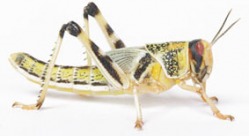
Info: Locusts are still uncommon in the pet trade in the Northern Americas but popular in the U.K. trade.
Nutritional Value:
Moisture % 62.3
Fat % 5.25
Ca:P Ratio % 1.7
Protein % 41.0
***CARESHEET/GUTLOADING INFORMATION NEEDED****
Size Range: 1/4" to 3"
Nutritional Value:
Moisture % 62.3
Fat % 5.25
Ca:P Ratio % 1.7
Protein % 41.0
***CARESHEET/GUTLOADING INFORMATION NEEDED****
Size Range: 1/4" to 3"
GRASSHOPPERS
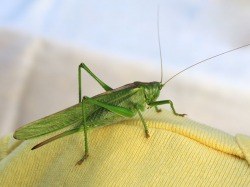
Nutrion Value: Adult
Insect Protein (g) 20.6
Fat (g) 6.1
Carbohydrate (g) 3.9
Calcium (mg) 35.2
Iron (mg) 5.0
Nutrition Value: Second stat ~ no further detail provided
Insect Protein (g) 14.3
Fat (g) 3.3
Carbohydrate (g) 2.2
Calcium (mg) 27.5
Iron 3.0
Insect Protein (g) 20.6
Fat (g) 6.1
Carbohydrate (g) 3.9
Calcium (mg) 35.2
Iron (mg) 5.0
Nutrition Value: Second stat ~ no further detail provided
Insect Protein (g) 14.3
Fat (g) 3.3
Carbohydrate (g) 2.2
Calcium (mg) 27.5
Iron 3.0
The crickets, grasshopper and locusts needs seem to be very close in nature...rather than divide into three sections I have included it in one. If you are aware of differences of importance please contact me: [email protected]
THE ROACH FAMILY
info: There are a wide variety of roaches available on the market. (Check your legality of keeping them! In some places/countries like Canada it is not legal to have them.) Pictured above is the Madagascar Hissing Cockroach.
This information is Private information obtained in conjunction with Blaberus.com and cannot be utilized or copied without written permission from the owners of this information. Please contact www.DoubleDs.org or www.Blaberus.com if you wish to utilize this information. Anyone who copies this information without written permission will face penalties by law.
After years of wondering which feeder is more superior? Is it Roaches or Crickets, or maybe even Meal worms? Well Double D's in conjunction with Blaberus.com have finally gotten you the facts you need to answer that question once and for all. So here it is.
This information was compiled by a well known food analysis company in New Jersey. They were asked to conduct a proximate analysis on 5 of the most common feeder insects on the market,
1. B. Laterallis
2. B. Dubia
3. Crickets
4. Meal worms
5. Portentosa = Giant Madagascar Hissing Cockroach
SAMPLE MOIST. PROTEIN FAT FIBER ASH
B. Laterallis 63.63% 36.5% 5.31% 2.19% 1.95%
B. Dubia 61.18% 35.6% 6.75% 3.25% 2.01%
Meal worms 58.74% 21.0% 15.52% 2.01% 1.18%
Crickets 71.96% 18.5% 6.26% 2.09% 1.29%
G. Portentosa 64.09% 26.7% 5.05% 5.62% 1.37%
COCKROACH CARE AND BREEDING
This information is Private information obtained in conjunction with Blaberus.com and cannot be utilized or copied without written permission from the owners of this information. Please contact www.DoubleDs.org or www.Blaberus.com if you wish to utilize this information. Anyone who copies this information without written permission will face penalties by law.
After years of wondering which feeder is more superior? Is it Roaches or Crickets, or maybe even Meal worms? Well Double D's in conjunction with Blaberus.com have finally gotten you the facts you need to answer that question once and for all. So here it is.
This information was compiled by a well known food analysis company in New Jersey. They were asked to conduct a proximate analysis on 5 of the most common feeder insects on the market,
1. B. Laterallis
2. B. Dubia
3. Crickets
4. Meal worms
5. Portentosa = Giant Madagascar Hissing Cockroach
SAMPLE MOIST. PROTEIN FAT FIBER ASH
B. Laterallis 63.63% 36.5% 5.31% 2.19% 1.95%
B. Dubia 61.18% 35.6% 6.75% 3.25% 2.01%
Meal worms 58.74% 21.0% 15.52% 2.01% 1.18%
Crickets 71.96% 18.5% 6.26% 2.09% 1.29%
G. Portentosa 64.09% 26.7% 5.05% 5.62% 1.37%
COCKROACH CARE AND BREEDING
THE WORMS/GRUBS
MINI MEALWORMS
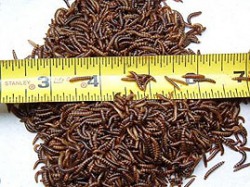
Info: Mini Mealworms are the larvae of a Darkling beetle and are quite similar to mealworms, except they are much smaller and not as widely available.
**Please note that I found no differentiating stats between mini mealies and mealie worms and have represented them as an equal.
Nutritional Value: Larvae
C.P. 52.7
C.F. 32.8
Ash 3.2
G.E. 6.49
C.A. .11
Nutritional Value: Beetle
C.P. 63.7
C.F. 18.4
Ash 3.1
G.E. 5.79
C.A. .07C.P.
Size Range: 1/4" to 3/4"
MEALWORMS
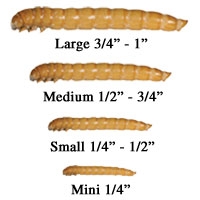
Info: Mealworms are the larvae of the Mealworm Beetle. They are another food item that is easy to buy for your reptiles.
Nutritional Value: Larvae
C.P. 52.7
C.F. 32.8
Ash 3.2
G.E. 6.49
C.A. .11
Nutritional Value: Beetle
C.P. 63.7
C.F. 18.4
Ash 3.1
G.E. 5.79
C.A. .07
For the best results for your reptile, feed the whitest larvae you can find. These have just shed and the chiten is then at its lowest.
Size Range: 1/4" to 1"
MAKING THE MOST OF THE MEALWORM
http://www.fishpondinfo.com/worm.htm
http://insected.arizona.edu/mealinfo.htm
Nutritional Value: Larvae
C.P. 52.7
C.F. 32.8
Ash 3.2
G.E. 6.49
C.A. .11
Nutritional Value: Beetle
C.P. 63.7
C.F. 18.4
Ash 3.1
G.E. 5.79
C.A. .07
For the best results for your reptile, feed the whitest larvae you can find. These have just shed and the chiten is then at its lowest.
Size Range: 1/4" to 1"
MAKING THE MOST OF THE MEALWORM
http://www.fishpondinfo.com/worm.htm
http://insected.arizona.edu/mealinfo.htm
KINGWORMS, SUPERS, MORIOS
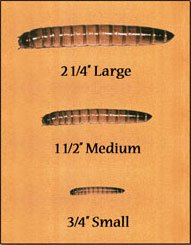
Info: Kingworms are the larvae of a Darkling beetle and are quite similar to mealworms, except they are much larger and not as widely available.
Nutritional Value:
Moisture: 59%
Protein: 20%
Fat: 16%
Ash: 1%
Size Range: 1/2" to 2.5"
KEEPING AND BREEDING SUPERWORMS / MORIOS
Nutritional Value:
Moisture: 59%
Protein: 20%
Fat: 16%
Ash: 1%
Size Range: 1/2" to 2.5"
KEEPING AND BREEDING SUPERWORMS / MORIOS
WAXWORMS
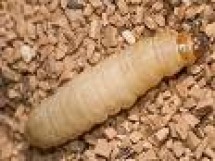
Info: Waxworms are the larvae of the waxmoth. They aren't as widely available as superworms and mealworms.
Nutritional Value:
C.P. 42.4
C.F. 46.4
Ash 2.7
G.E. 7.06
C.A. 0.11
Size Range: usually around 1/2 inch
BREEDING WAXWORMS
Nutritional Value:
C.P. 42.4
C.F. 46.4
Ash 2.7
G.E. 7.06
C.A. 0.11
Size Range: usually around 1/2 inch
BREEDING WAXWORMS
TREVOWORMS / BUTTERWORMS
Info: Butterworms are the larvae of the Chilean Moth (Chilecomadia moorei). They aren't as widely available as some other foods listed. They naturally have a red tint and sweet fragrance to them which often stimulates appetite. Butterworms in the USA cannot be used to breed because when they are imported they are sterilized to prevent possible establishment in the wild.
Size Range: usually around 1/2 - 2 inches
Nutritional Information:
Moisture: 58.54
Ash: 1.04
Protein: 16.20
Fat: 5.21
Calories/Fat: 87.73
Calcium (ml/100 grs): 42.90
Warning: There have been a couple of reported cases of butterworms causing harm to geckos. Please note that despite the fact these reports only cover 3 species, it does not in any way mean that they can't cause harm to other species of gecko or reptile. use with caution. The following represents a very isolated case that has not been researched or explained.
WARNING: USE CAUTION WITH BUTTERWORMS
BUTTERWORMS RECIEVE RADIATION PRIOR TO RECEIPT INTO THE COUNTRY. THIS ENSURES THEY ARE UNABLE TO BREED AND THEREFORE SAFE FROM INFESTATION. I WON'T BE PROVIDING A BREEDING PAGE.
ALSO BUTTERWORMS ARE NOT FARMED BY WILD CAPTURED.
Size Range: usually around 1/2 - 2 inches
Nutritional Information:
Moisture: 58.54
Ash: 1.04
Protein: 16.20
Fat: 5.21
Calories/Fat: 87.73
Calcium (ml/100 grs): 42.90
Warning: There have been a couple of reported cases of butterworms causing harm to geckos. Please note that despite the fact these reports only cover 3 species, it does not in any way mean that they can't cause harm to other species of gecko or reptile. use with caution. The following represents a very isolated case that has not been researched or explained.
WARNING: USE CAUTION WITH BUTTERWORMS
BUTTERWORMS RECIEVE RADIATION PRIOR TO RECEIPT INTO THE COUNTRY. THIS ENSURES THEY ARE UNABLE TO BREED AND THEREFORE SAFE FROM INFESTATION. I WON'T BE PROVIDING A BREEDING PAGE.
ALSO BUTTERWORMS ARE NOT FARMED BY WILD CAPTURED.
PHOENIX WORMS
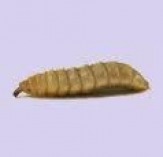
Info: Phoenix Worms are the larvae of the Black Soldier Fly (Hermetia Illucens).
Nutritional Value:
C.P. 42.1
C.F. 34.8
Ash 14.6
G.E.
C.A. 5.36
When feeding phenix worms supplementation for calcium is unneccessary. a great feeder for both gravid and recouperating females.
Size Range: usually around 1/2"
Phoenix worms are being found very useful in the vermicomposting fields.
Further information and reading:
Black Soldier Fly Larvae (Calciworms) as Food for Reptiles and Amphibians
Nutritional Value:
C.P. 42.1
C.F. 34.8
Ash 14.6
G.E.
C.A. 5.36
When feeding phenix worms supplementation for calcium is unneccessary. a great feeder for both gravid and recouperating females.
Size Range: usually around 1/2"
Phoenix worms are being found very useful in the vermicomposting fields.
Further information and reading:
Black Soldier Fly Larvae (Calciworms) as Food for Reptiles and Amphibians
SILKWORM
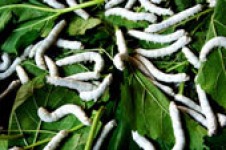
Info: Silkworms are the larvae of the silk moth. They are the same caterpillars that produce silk for clothing.
Nutritional Value:
C.P. 17.3
C.F. 9.4
Ash
G.E. 54.
C.A. 8155 CPPM
Silkworms are very good nutritionally. They are high in moisture and calcium, not too high in fat, and have no tough exoskeleton to worry about. These are an unbeatable source for calcium for gravid females and those having just laid to replentish supplies, or for reptiles showing or diagnosed with MBD.
Size Range: 1" to 2"
http://www.wormspit.com/bombyxsilkworms.htm
http://www.chameleonnews.com/?page=article&id=56
http://www.chameleonforums.com/silkworms-101-a-7906/
Nutritional Value:
C.P. 17.3
C.F. 9.4
Ash
G.E. 54.
C.A. 8155 CPPM
Silkworms are very good nutritionally. They are high in moisture and calcium, not too high in fat, and have no tough exoskeleton to worry about. These are an unbeatable source for calcium for gravid females and those having just laid to replentish supplies, or for reptiles showing or diagnosed with MBD.
Size Range: 1" to 2"
http://www.wormspit.com/bombyxsilkworms.htm
http://www.chameleonnews.com/?page=article&id=56
http://www.chameleonforums.com/silkworms-101-a-7906/
EARTHWORMS
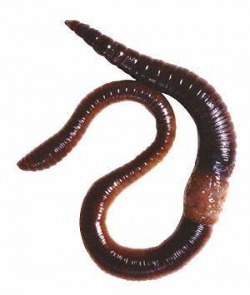
Nutritional Value: Earthworm
C.P. 62.2
C.F. 17.7
Ash 5.0
G.E. 4.65
C.A. 1.72
Nutritional Value: Night Crawler
C.P. 60.7
C.F. 4.4
Ash 11.4
G.E. 4
Info: You want a lean, mean fighting machine, look in this direction. High water content is great for ensuring your reptile remains hydrated. As a feeder for an overweight reptile I have found the earthworm family very useful. Did you know that adding earthworms to your diet on a regular basis will help to avoid gout? Recommended as well for the animals suffering from the condition.
Size Range: upto 6"
Ideal For: most lizards and amphibians
"Raising Earthworms", by Mary Hysong
http://www.wormdigest.org/content/view/58/2/
REDWORMS
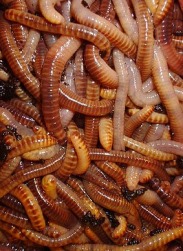
Info: Red worms aren't common in the pet trade. They are normally used for composting and the easiest place to buy them is from places selling composting supplies. Redworms do not survive most terrarium existances. To accomplish this in yours you need to keep a composting corner this will solve the problem.
Nutritional Analysis of Red Worms:
Moisture- 84.8%
Fat- 2.0%
Ash-0.7%
Protein- 10.5%
Size Range: upto 6"
VERMICOMPOSTING/RED WORMS
Nutritional Analysis of Red Worms:
Moisture- 84.8%
Fat- 2.0%
Ash-0.7%
Protein- 10.5%
Size Range: upto 6"
VERMICOMPOSTING/RED WORMS
GOLIATH WORMS (TOMATO WORMS)
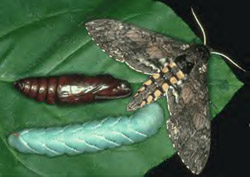
Info: Goliath worms are the larva of the Five-Spotted Hawkmoth (Manduca quinquemaculata). These are relatively new on the market but are quickly growing in popularity. They are fast growing and will grow to be about 4 inches long. If you let them pupate fully, they turn into a large moth with a 3-4 inch wingspan.
Nutritional Value:
Still missing the stats on this one. But in doing this page there is a pattern emerging. Check the other grubs and look to see how close they are. ie. crickets and grasshoppers, 19 differing species of lizard, look at the crustacians that are clustered together. It is by no means a perfect little system but it may help give you an approximation or range.
Size Range: 1" - 4"
http://answers.yahoo.com/question/index?qid=20090522235936AA9qlg9
http://hermitlovers.com/HornWorms_care_sheet_PDF.pdf
http://forums.gardenweb.com/forums/load/butterfly/msg0721434326221.html
http://rhosgobel.blogspot.com/2004/11/adults-have-arrived.html
http://www.entm.purdue.edu/Entomology/outreach/recipe/manduca.diet.htm
TUBIFEX WORMS
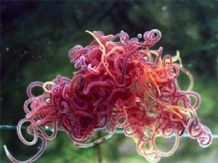
Protein: 46.1
Fat: 15.1
Kcal: N/A
Calcium: .19
Ca:P 0:26
Fat: 15.1
Kcal: N/A
Calcium: .19
Ca:P 0:26
BLOODWORMS
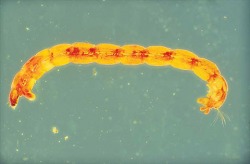
The majority of Bloodworms or Non-biting Midges are found in the top five centimetres of sediment (sludge at the bottom of streams). Some can live in mud and water with low levels of oxygen. They are an important source of food for larger aquatic insects and fish.
Protein: 52.8
Fat: 9.7
Kcal: N/A
Calcium: .38
Ca:P 0:42
Protein: 52.8
Fat: 9.7
Kcal: N/A
Calcium: .38
Ca:P 0:42
BLACKWORMS

Black worms are small, aquatic relatives of earthworms and are readily available in the pet trade. They should be stored in a refrigerator, where they will live for at least two weeks if the water is changed daily.
Protein: 47.8
Fat: 20.1
Kcal: 5.57
Calcium: .11
Ca:P 0:12
Keeping Info: http://www.aquariumfish.net/information/black_worms.htm
Protein: 47.8
Fat: 20.1
Kcal: 5.57
Calcium: .11
Ca:P 0:12
Keeping Info: http://www.aquariumfish.net/information/black_worms.htm
SPRINGTAILS
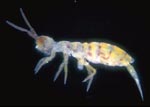
I have been unable to find any nutrition stats on springtails.
KEEPING AND CULTURING SPRINGTAILS:
http://www.dartfrog.tk/index.php?page=springtails
http://insects.tamu.edu/fieldguide/aimg1.html
FRUIT FLY
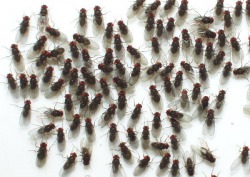
Info: Fruit Flies come in 2 species, Drosophila Melanogaster and Drosophila Hydei. they look nearly the same, except the 2nd one is slightly larger but reproduces slower. They are easy to culture and widely available online. However, due to their very small size they aren't good for feeding to anything but very small lizards and dart frogs.
Nutritional Value: Adult
C.P. 62.2
C.F. 17.7
Ash 5.0
G.E. 4.65
C.A. 1.72
Nutritional Value: Larvae
C.P. 40.3
C.F. 29.4
Ash 5.57
Calcium: 0.010
Ca:P 0.25
Size Range: 1-2mm
http://www.squidoo.com/raisefruitflies
Nutritional Value: Adult
C.P. 62.2
C.F. 17.7
Ash 5.0
G.E. 4.65
C.A. 1.72
Nutritional Value: Larvae
C.P. 40.3
C.F. 29.4
Ash 5.57
Calcium: 0.010
Ca:P 0.25
Size Range: 1-2mm
http://www.squidoo.com/raisefruitflies
HOUSE FLY MAGGOTS
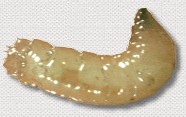
Protein: 56.2
Fat: 20.
Kcal: 6.07
Calcium: 0.41
Ca:P: 0:36
Fat: 20.
Kcal: 6.07
Calcium: 0.41
Ca:P: 0:36
OTHER
JUNE BEETLE/BUG
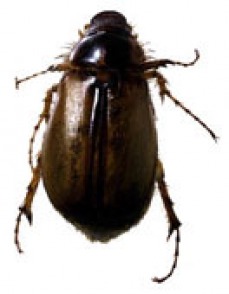
Nutrional Value
Protein (g) 13.4
Fat (g) 1.4
Carbohydrate 2.9
Calcium (mg) 22.6
Iron (mg) 6.0
Info: Fruit Beetle Grubs are the larvae of the Fruit Beetle, also known as Japanese Beetles and June Bugs. Since they aren't common in the pet trade, the easiest way to get some of these is from places selling live bait for fishing.
Size Range: 1/2" - 2"
Protein (g) 13.4
Fat (g) 1.4
Carbohydrate 2.9
Calcium (mg) 22.6
Iron (mg) 6.0
Info: Fruit Beetle Grubs are the larvae of the Fruit Beetle, also known as Japanese Beetles and June Bugs. Since they aren't common in the pet trade, the easiest way to get some of these is from places selling live bait for fishing.
Size Range: 1/2" - 2"
WOODLICE ~ CRUSTACIAN
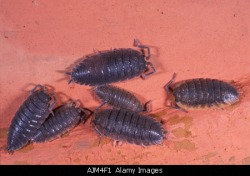
Info: Woodlice are actually crustacians, not insects, and they come in many sizes and species. They are easy to breed and care for and are also beneficial to the soil of planted terrariums since they eat decaying organic matter. Unlike in insects, the exoskeleton of the woodlouse is made of calcium not chitin and the hardness of it depends on the species.
Nutritional Value:
Not yet found, see note above, check the other crustacians (just below) section on this one.
Depends on the species. high in calcium
Size Range: 1/32" to 1/2"
ISOPODS
http://insected.arizona.edu/isorear.htm
http://chamownersweb.net/insects/pillbugs.htm
http://www.uky.edu/Ag/CritterFiles/casefile/relatives/sowbugs/sowbug.htm
http://www.nilesbio.com/prod95.html
http://www.chameleonforums.com/blogs/sandrachameleon/196-terrestrial-isopods-pillbugs-wood-sow-rollie-pollie.html
http://www.nilesbio.com/prod94.html
Nutritional Value:
Not yet found, see note above, check the other crustacians (just below) section on this one.
Depends on the species. high in calcium
Size Range: 1/32" to 1/2"
ISOPODS
http://insected.arizona.edu/isorear.htm
http://chamownersweb.net/insects/pillbugs.htm
http://www.uky.edu/Ag/CritterFiles/casefile/relatives/sowbugs/sowbug.htm
http://www.nilesbio.com/prod95.html
http://www.chameleonforums.com/blogs/sandrachameleon/196-terrestrial-isopods-pillbugs-wood-sow-rollie-pollie.html
http://www.nilesbio.com/prod94.html
CRUSTACEANS, CRAYFISH, MIXED SPECIES, WILD, RAW
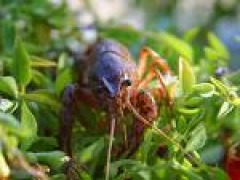
In a serving of 3 - 4 ounces of crayfish, (7 to 8)
you can expect the following amounts of nutrients:
Total fat 1 g.
Cholesterol 126 mg
Total Carbohydrate 0 g.
Protein 16 g.
Calories 80
RAISING: SHRIMP, CRABS AND CRAYFISH FOR THE AQUARIUM:
http://www.shrimpcrabsandcrayfish.co.uk/Site/Shrimp.htm?Shrimpfr.htm~mainFrame
RAISING CRAYFISH:
http://varanidae.org/Varanews/VN3_1.pdf
THIS ONE IS FOR IVORY0DAWN AND NACHO
MIXED SPECIES SHRIMP DATA
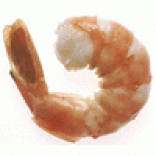
Our food ranking system qualified shrimp as an excellent source of selenium and unusually low-fat, low-calorie protein--a four ounce serving of shrimp supplies 23.7 grams of protein (that's 47.4% of the daily value for protein) for a mere 112 calories and less than a gram of fat. Shrimp also emerged as a very good source of vitamin D and vitamin B12.
RAISING: SHRIMP, CRABS AND CRAYFISH
http://www.shrimpcrabsandcrayfish.co.uk/Site/Shrimp.htm?Shrimpfr.htm~mainFrame
RAISING: SHRIMP, CRABS AND CRAYFISH
http://www.shrimpcrabsandcrayfish.co.uk/Site/Shrimp.htm?Shrimpfr.htm~mainFrame
ANCHOVI AND SQUID
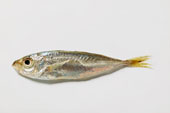
SQUID ANCHOVI
Protein: 84.2 Protein: 74
Fat: 5.3 Fat: 18.5
Kcal: 4.16 Kcal: 4.85
Calcium: 0.47 Calcium: 0.54
Ca:P 0:23 Ca:P 0.84
Protein: 84.2 Protein: 74
Fat: 5.3 Fat: 18.5
Kcal: 4.16 Kcal: 4.85
Calcium: 0.47 Calcium: 0.54
Ca:P 0:23 Ca:P 0.84
HARVESTER ANTS
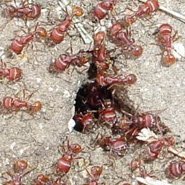
Info: Ants aren't a common reptile food unless you own a horned lizard, which only eats Harvester Ants. If wild ants get in to your enclosure, your reptiles may eat them anyway. However, if you have ant poison around your house then it may be possible for the ant to get in to the poison before getting eaten by your reptile, which could result in a sick or dead reptile.
Nutritional Value:
C.P.
C.F.
Ash
G.E.
C.A.
Size Range: 1/16" to 1/2"
http://wichitafallsreptilerescue.webs.com/harvesterants.htm
Nutritional Value:
C.P.
C.F.
Ash
G.E.
C.A.
Size Range: 1/16" to 1/2"
http://wichitafallsreptilerescue.webs.com/harvesterants.htm
RED ANTS
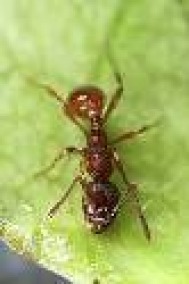
Nutrition Stats
Protein (g) 13.9
Fat (g) 3.5
Carbohydrate 2.9
Calcium (mg) 47.8
Iron (mg) 5.7
Protein (g) 13.9
Fat (g) 3.5
Carbohydrate 2.9
Calcium (mg) 47.8
Iron (mg) 5.7
CICADAS
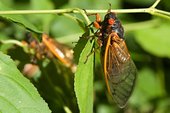
FLOUR BEETLES AND LARVA
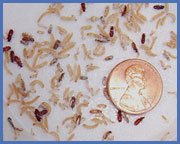
Info: Somewhat a common food for Dart Frogs, these are easy to breed and care for.
Nutritional Value:
C.P.
C.F.
Ash
G.E.
C.A.
unknown
Size Range: Larvae are 1/4" Adults are 1/8"
Nutritional Value:
C.P.
C.F.
Ash
G.E.
C.A.
unknown
Size Range: Larvae are 1/4" Adults are 1/8"
TERMITES
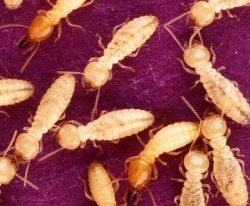
Info: Termites are very uncommon in the pet trade due to the fact that they are very destructive to wood structures. Not much info is known on them yet. they are usually used by dart frog owners.
Nutritional Value:
Protein (g) 14,2
Fat (g) N/A
Carbohydrate N/A
Calcium (mg) N/A
Iron (mg) 35.5
Size Range: under 1/2"
BUILDING A TERMITE TRAP
Nutritional Value:
Protein (g) 14,2
Fat (g) N/A
Carbohydrate N/A
Calcium (mg) N/A
Iron (mg) 35.5
Size Range: under 1/2"
BUILDING A TERMITE TRAP
GIANT WATER BEETLE

Protein (g) 19.8
Fat (g) 8.3
Carbohydrate 2.1
Calcium (mg) 43.5
Iron (mg) 13.6
Fat (g) 8.3
Carbohydrate 2.1
Calcium (mg) 43.5
Iron (mg) 13.6
DUNG BEETLE
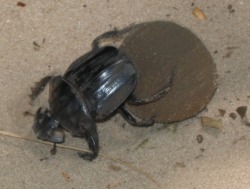
Nutritional Value
Protein (g) 17.2
Fat (g) 4.3
Carbohydrate 0.2
Calcium (mg) 30.9
Iron (mg) 7.7
Protein (g) 17.2
Fat (g) 4.3
Carbohydrate 0.2
Calcium (mg) 30.9
Iron (mg) 7.7
FEEDER FISH
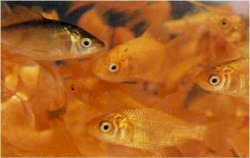
Info: Feeder fish are very common in the pet market and are usually very easy and cheap to care for. They are usually just cheap small goldfish, but can also be minnows or guppies. They are normally used as fishing bait or to feed other fish or turtles. not all reptiles will accept feeder fish, and some will only eat fish. if you need to use feeder fish, it would be good to feed them healthy foods for a bit prior to using them. many times the fish available in petshops aren't very healthy and could be diseased due to over crowding and poor practices regarding breeding them resulting in malnutrition, stunted growth, and suppressed immune systems.
Goldfish should be fed only on a one per month basis and other live fish easily raised are guppies, mollies, swordtails are recommended over the common goldfish. These have been linked to vitamin A overdoses in matamata turtles. While seemingly healthy on a diet heavily or solely invested in Gfish they were dying in the 5 to 7 year age group and found to have high fat deposits and liver and kidney damage. Spring is a great time to check out your local rivers and creeks for hatchlings to feed your pet. As with all feeders moderation and variety are recommended.
Size Range: 1" to 4" (not including tail)
Goldfish should be fed only on a one per month basis and other live fish easily raised are guppies, mollies, swordtails are recommended over the common goldfish. These have been linked to vitamin A overdoses in matamata turtles. While seemingly healthy on a diet heavily or solely invested in Gfish they were dying in the 5 to 7 year age group and found to have high fat deposits and liver and kidney damage. Spring is a great time to check out your local rivers and creeks for hatchlings to feed your pet. As with all feeders moderation and variety are recommended.
Size Range: 1" to 4" (not including tail)
SALMON
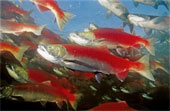
Protein: 63.5
Fat: 34.2
Kcal: 5.90
Calcium: 0.39
Ca:P 0.05
Fat: 34.2
Kcal: 5.90
Calcium: 0.39
Ca:P 0.05
CODFISH
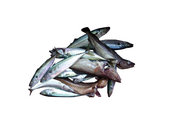
Protein: 93.4
Fat: 4.56
Kcal: 4.31
Calcium: 0.84
Ca:P: 0.08
Fat: 4.56
Kcal: 4.31
Calcium: 0.84
Ca:P: 0.08
MOSQUITO LARVAE
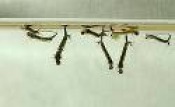
Protein: 42.2
Fat: 16.1
Kcal: N/A
Calcium: 0.79
Ca:P: 0.73
Fat: 16.1
Kcal: N/A
Calcium: 0.79
Ca:P: 0.73
DAPHNIA ~ WATER FLEA
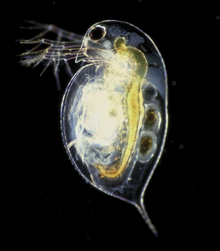
Protein: 55.2
Fat: 6.6
Kcal: N/A
Calcium: 0.10
Ca:P 0:0.08
Fat: 6.6
Kcal: N/A
Calcium: 0.10
Ca:P 0:0.08
MILKWEED BUG
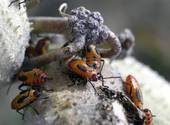
SNAILS
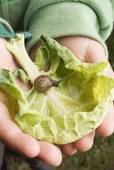
Energy (kcal): 80.5
Water (g): 79
Protein (g): 16
Available carbohydrates (g): 2
Fibres (g): 0
Fat (g): 1
Magnesium (mg): 250
Calcium (mg): 170
Iron (mg): 3.5
Vitamin C (mg): 0
RAISING SNAILS:
http://varanidae.org/Varanews/VN3_1.pdf refer to page 3/4
http://www.nalusda.gov/afsic/AFSIC_pubs/srb96-05.htm
BOGONG MOTH ~ FOR THE AUSSIES
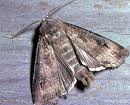
Although I have been unable to date to find the exact stats for the Bogong I have found: 100 grams of the abdomin of the moth is comparable in fat to the same ratio of a Big Mac! It also has a very high protein amount. The aboriginals of Australia have been eating this tasty moth for centuries, often roasted the process burns the wings, legs off then the head is removed.
MOLLUSKS
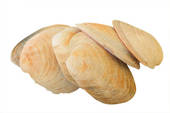
WHOLE VERTEBRATE FOODS
The following listed values may have some fluctuations in both age and diet being fed.
MICE
Info: Mice are the most common food for snakes and large meat eating lizards such as monitors. They are very easy to buy from pet shops and very easy to breed. You can get them living or frozen.
Nutritional Value:
Neonatal, <3 g
Crude Protein: 64.2
Crude Fat: 17.0
Ash: 9.7
Kcal: 4.87
Juvenile, 3-10 g
Crude Protein: 44.2
Crude Fat: 30.1
Ash: 8.5
Kcal: 6.65
Adult or >10 g
Crude Protein: 55.8
Crude Fat: 23.6
Ash: 11.8
Kcal: 5.25
Size Range: 1" to 4" (not including tail)
RAISING FEEDER MICE FOR PROFIT: http://www.captivebred.com/How%20to%20set%20up%20a%20mouse%20colony.htm
BREEDING VS. BUYING THREAD: http://www.ssnakess.com/forums/general-discussion/83282-breeding-vs-buying-mice-rats.html
Nutritional Value:
Neonatal, <3 g
Crude Protein: 64.2
Crude Fat: 17.0
Ash: 9.7
Kcal: 4.87
Juvenile, 3-10 g
Crude Protein: 44.2
Crude Fat: 30.1
Ash: 8.5
Kcal: 6.65
Adult or >10 g
Crude Protein: 55.8
Crude Fat: 23.6
Ash: 11.8
Kcal: 5.25
Size Range: 1" to 4" (not including tail)
RAISING FEEDER MICE FOR PROFIT: http://www.captivebred.com/How%20to%20set%20up%20a%20mouse%20colony.htm
BREEDING VS. BUYING THREAD: http://www.ssnakess.com/forums/general-discussion/83282-breeding-vs-buying-mice-rats.html
RATS
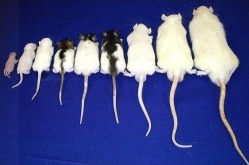
Info: Rats are also a very common food for snakes and large meat eating lizards such as monitors. They are very easy to buy from pet shops and very easy to breed. You can get them living or frozen. They are also much friendlier then mice
Nutritional Value:
Adult or >50 g
Crude protein: 61.8
Crude Fat: 32.6
Ash: 9.8
Kcal: 6.37ª
Neonatal, <10 g
Crude Protein: 57.9
Crude Fat: 23.7
Ash: 12.2
Kcal: 5.30ª
Size Range: 2" - 10" (not including tail)
KEEPING AND BREEDING RATS
http://www.quite.co.uk/rats/
Nutritional Value:
Adult or >50 g
Crude protein: 61.8
Crude Fat: 32.6
Ash: 9.8
Kcal: 6.37ª
Neonatal, <10 g
Crude Protein: 57.9
Crude Fat: 23.7
Ash: 12.2
Kcal: 5.30ª
Size Range: 2" - 10" (not including tail)
KEEPING AND BREEDING RATS
http://www.quite.co.uk/rats/
ANOLES
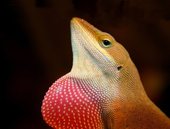
Nutrition Value
D.M. 30.3
C.P. 67.4
C.F. N/A
Ash N/A
G.E. N/A
D.M. 30.3
C.P. 67.4
C.F. N/A
Ash N/A
G.E. N/A
BEARDED DRAGON
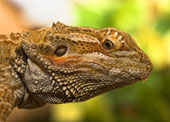
Nutrition Value
D.M. 17.9
C.P. 63.6
C.F. N/A
Ash N/A
G.E. N/A
D.M. 17.9
C.P. 63.6
C.F. N/A
Ash N/A
G.E. N/A
LIZARDS
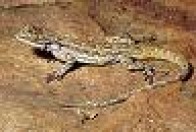
Nutrition Value: 19 differing species
D.M. 28.8
C.P. N/A
C.F. N/A
Ash 4.8
G.E. N/A
D.M. 28.8
C.P. N/A
C.F. N/A
Ash 4.8
G.E. N/A
CUBAN TREE FROG
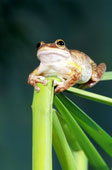
Nutrition Value
D.M. 26.4
C.P. N/A
C.F.
Ash
G.E.
D.M. 26.4
C.P. N/A
C.F.
Ash
G.E.
GREEN FROG
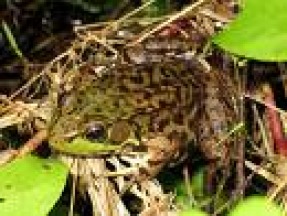
Nutrition Value
D.M. 22.5
C.P. 71.2
C.F. 10.2
Ash N/A
G.E. N/A
D.M. 22.5
C.P. 71.2
C.F. 10.2
Ash N/A
G.E. N/A
SOUTHERN TOAD (BUFO)
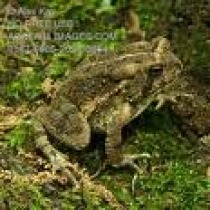
Nutrition Value
D.M. 26.4
C.P. 61.8
C.F. 13.7
Ash N/A
G.E. 4.61
D.M. 26.4
C.P. 61.8
C.F. 13.7
Ash N/A
G.E. 4.61
SNAKE
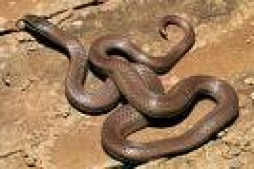
Nutrition Value: 4 SPECIES USED
D.M. 28.0
C.P. N/A
C.F. N/A
Ash 17.0
G.E. 6.51
D.M. 28.0
C.P. N/A
C.F. N/A
Ash 17.0
G.E. 6.51
HAMSTERS
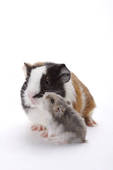
Nutrition Value
D.M. 30.3
C.P. 49.8
C.F. 34.7
Ash 7.5
G.E. 5.98
http://www.hamstercentral.com/wiki/Breeding_hamsters_as_a_hobby_and_Hamsteries
D.M. 30.3
C.P. 49.8
C.F. 34.7
Ash 7.5
G.E. 5.98
http://www.hamstercentral.com/wiki/Breeding_hamsters_as_a_hobby_and_Hamsteries
GUINNEA PIG
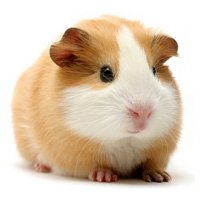
Info: Guinea Pigs are sometimes fed to large snakes such as boas and pythons. they aren't commonly sold as a food item by pet shops so it will cost a bit more if you want to buy live Guinea Pigs to breed. however, they can often be bought online frozen.
Nutritional Value: Males, 10 week
Protein: 51.4
Fat: 46.1
ASH: 9.2
KCAL: 6.99ª
Size Range: 4" - 12"
http://tolweb.org/treehouses/?treehouse_id=4713
Nutritional Value: Males, 10 week
Protein: 51.4
Fat: 46.1
ASH: 9.2
KCAL: 6.99ª
Size Range: 4" - 12"
http://tolweb.org/treehouses/?treehouse_id=4713
RABBIT
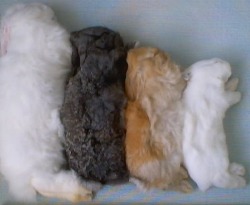
Info: Rabbits are often fed to large snakes such as boas and pythons that are 10ft or longer or large crocodilians. They aren't commonly sold as a food item by pet shops so it will cost a bit more if you want to buy live rabbits to breed. however, they can often be bought online frozen.
Nutritional Value: Adult
Crude Protein: 63.5
Crude Fat:15.3
Ash: 9.4
Kcal: 5.41
Size Range: 4" - 14"
http://www.backwoodshome.com/articles2/peterson106.html
Nutritional Value: Adult
Crude Protein: 63.5
Crude Fat:15.3
Ash: 9.4
Kcal: 5.41
Size Range: 4" - 14"
http://www.backwoodshome.com/articles2/peterson106.html
CHICKEN
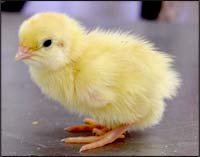
Info: Chickens usually aren't sold in pet shops, live or frozen. usually you have to get them from farm supply stores, either at the store itself or online. its also possible to get frozen chickens online. usually people only buy adult chickens for very large snakes that are 15ft or longer or for very large crocodilians.
Nutritional Value: One-day-old
Crude Protein: 64.9
crude Fat: 22.4
Ash: 6.4
Kcal: 5.80
Nutritional Value: adult
Crude Protein: 42.3
Crude Fat: 37,8
Ash: 9.4
Kcal: 5.90
Size Range:tennis ball sized to bowling ball sized
Nutritional Value: One-day-old
Crude Protein: 64.9
crude Fat: 22.4
Ash: 6.4
Kcal: 5.80
Nutritional Value: adult
Crude Protein: 42.3
Crude Fat: 37,8
Ash: 9.4
Kcal: 5.90
Size Range:tennis ball sized to bowling ball sized
CHICKEN BREAST
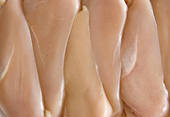
NUTRITIONAL VALUES:
Protein: 92.0
Fat: 4.0
Kcal: 4.4
Calcium: .784
Ca:P 0.06
Protein: 92.0
Fat: 4.0
Kcal: 4.4
Calcium: .784
Ca:P 0.06
JAPANESE / BUTTON QUAIL
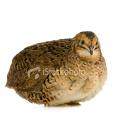
Nutrition Value
D.M. 34.6
C.P. 71.5
C.F. 31.9
Ash 9.9
G.E. 6.79
KEEPING AND BREEDING QUAIL
http://www.thatquailplace.com/articles/index.php?id=8
http://www.chinesepaintedquail.co.uk/quails_incubation_brooder.html
D.M. 34.6
C.P. 71.5
C.F. 31.9
Ash 9.9
G.E. 6.79
KEEPING AND BREEDING QUAIL
http://www.thatquailplace.com/articles/index.php?id=8
http://www.chinesepaintedquail.co.uk/quails_incubation_brooder.html
PIG
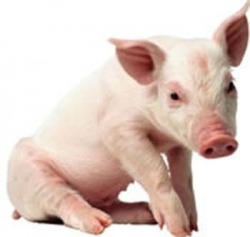
Info: Pigs usually aren't sold in pet shops, live or frozen. usually you have to get them from farm supply stores, either at the store itself or online. its also possible to get frozen pigs online. usually people only buy pigs for snakes that are 20ft or longer or for large crocodilians such as alligators.
Nutritional Value: Juvenile
Crude Protein: 50.7
Crude Fat:33:.2
Ash 11.9
Kcal: 5.78
Nutritional Value: Juvenile
Crude Protein: 50.7
Crude Fat:33:.2
Ash 11.9
Kcal: 5.78
BEEF HEART AND BEEF LIVER
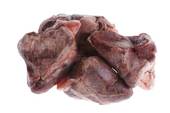
HEART LIVER
Protein: 79.6 Protein: 69.0
Fat: 16.1 Fat: 13.8
Kcal: 4.78 Kcal: 4.66
Calcium 0.75 Calcium 1.33
Ca:P 0:0.11 Ca:P 0:0.01
Protein: 79.6 Protein: 69.0
Fat: 16.1 Fat: 13.8
Kcal: 4.78 Kcal: 4.66
Calcium 0.75 Calcium 1.33
Ca:P 0:0.11 Ca:P 0:0.01
FYI
FIREFLIES, LIGHTNING BUGS
= DEATH WITHIN 24 HRS.
DIY AND TRAPPING METHODS FOR BUGS
WILD CAUGHT LIZARD FOOD
SOURCES AND RESOURCES
The first 4 links will provide you with the technical papers that explain and give many more details on the scope and nature of the testing, detailed analysis of vitamin contents, and more.
http://www.nal.usda.gov/awic/zoo/WholePreyFinal02May29.pdf
http://www.nagonline.net/Technical%2...cal_papers.htm
http://www.nagonline.net/index.html
http://www.nagonline.net/Technical%20Papers/NAGFS00397Insects-JONIFEB24,2002MODIFIED.pdf
http://www.caudata.org/cc/articles/foods2.shtml
http://www.caudata.org/cc/articles/foods.shtml
http://www.food-insects.com/Insects%20as%20Human%20Food.htm
http://www.ent.iastate.edu/Misc/insectnutrition.html
http://doubleds.org/contactus.html
http://sleepydeegeckos.webs.com/care.htm#Livefood
http://www.rodentpro.com/qpage_articles_03.asp
http://www.beautifuldragons.503xtreme.com/Nutrition.html
http://edibug.wordpress.com/nutritional-info/
http://www.nutritiondata.com/facts/finfish-and-shellfish-products/4168/2
http://www.trapperarne.com/nutrition.htm
http://wichitafallsreptilerescue.webs.com/harvesterants.htm
CALORIES - HOW TO RESTRICT; HOW TO INCREASE
http://www.chameleonnews.com/?page=article&id=92
INSECT INDENTIFICATION PHOTO GUIDE
http://www.insectidentification.org/insect-identification.asp
POND INSECTS
http://www.buzzle.com/articles/pond-insects.html
http://www.nal.usda.gov/awic/zoo/WholePreyFinal02May29.pdf
http://www.nagonline.net/Technical%2...cal_papers.htm
http://www.nagonline.net/index.html
http://www.nagonline.net/Technical%20Papers/NAGFS00397Insects-JONIFEB24,2002MODIFIED.pdf
http://www.caudata.org/cc/articles/foods2.shtml
http://www.caudata.org/cc/articles/foods.shtml
http://www.food-insects.com/Insects%20as%20Human%20Food.htm
http://www.ent.iastate.edu/Misc/insectnutrition.html
http://doubleds.org/contactus.html
http://sleepydeegeckos.webs.com/care.htm#Livefood
http://www.rodentpro.com/qpage_articles_03.asp
http://www.beautifuldragons.503xtreme.com/Nutrition.html
http://edibug.wordpress.com/nutritional-info/
http://www.nutritiondata.com/facts/finfish-and-shellfish-products/4168/2
http://www.trapperarne.com/nutrition.htm
http://wichitafallsreptilerescue.webs.com/harvesterants.htm
CALORIES - HOW TO RESTRICT; HOW TO INCREASE
http://www.chameleonnews.com/?page=article&id=92
INSECT INDENTIFICATION PHOTO GUIDE
http://www.insectidentification.org/insect-identification.asp
POND INSECTS
http://www.buzzle.com/articles/pond-insects.html
